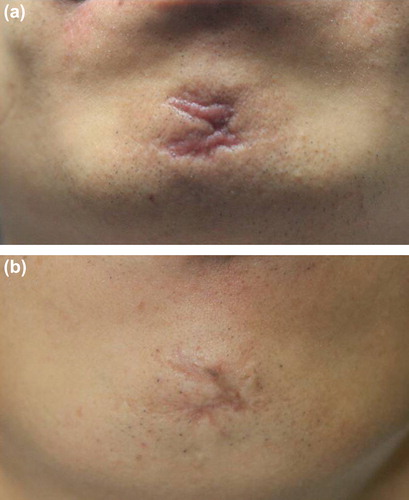Dear Editor,
Facial scars can result from several pathologic conditions, such as acne, scleroderma, cutaneous lupus erythematosus, postviral complications from viruses such as varicella-zoster, or trauma, as in the case described herein. These scars lead not only to cosmetic problems, but also to psychological effects such as emotional debilitation, embarrassment, poor self-esteem, and social isolation.
Although there are a variety of techniques for the correction of facial scars, radiofrequency (RF) treatment is recently used modality for scar correction (Citation1). RF device delivers uniform heat to the dermis to induce collagen remodeling (Citation2). A minimally invasive intradermal needle RF device (INNOfill, Pacific Pharma, Korea) was applied to treat facial scars (). The devices incorporated 21-, 27-, or 30-gauge RF needle electrodes in combination with a patch-type electrode. The entire RF needle was insulated with a biocompatible parylene layer, leaving the distal 1 mm exposed to act as the electrode in the tissue. A separately conducted RF needle designed to apply radiofrequency was inserted into the skin to stimulate initial collagen contraction and a wound healing response.
Figure 1. (a) Novel minimally invasive radiofrequency device. (b) Procedure: (Citation1) Insertion of the needle into the scar at variable depths from the superficial to mid-dermis (Citation2) ‘in situ’ 360 degree rotation (tunneling) performed to create a virtual canal contextually supplying the radiofrequency (Citation3) Repetition of the procedure in retrograde using a multi-prick technique along the scar.

A 32-year-old man presented with a single erythematous, depressed, curved burn scar on the chin (). The patient was worried about the cosmetic appearance of the chin defect. We decided to use the intradermal needle RF device at 18 W (Level 7 at 1 MHz) with an insulation-coated 27-gauge needle. The needle was inserted along the chin scar and RF was applied to this area while the needle was rotated 360°. He received four sessions of treatment to the scar lesion at 2-week intervals. The treatment resulted in significant improvement of the lesion, with good cosmetic results (). No adverse effects were evident with the exception of some spot bleeding at the injection sites and slight erythema that resolved within 48 h. The patient was satisfied with the outcome of treatment.
Figure 2. (a) Depressed, curved facial scar on the mid-chin and (b) marked improvement 2 months after intradermal RF treatment.

This new device delivers RF via an intradermal needle, thus creating tunnel-like coagulation canals inside the dermis and subcutaneous tissues. Furthermore, the intradermal RF device intrinsically improves scars by remodeling of the dermal component (Citation3). It is clear that RF energy reduces elastotic material by the reorientation of elastic material and induces new collagen formation (Citation4).
In conclusion, this new intradermal needle RF treatment may be a safe and effective method for the treatment of facial scars. This technique could be applied in various fields for the treatment of dermatologic scars and surgical scars, and can achieve excellent clearance in an easy and safe manner. However, further studies with longer follow-up times, large numbers, and comparison with conventional methods are warranted to elucidate the efficacy and safety of this new method.
Notice of Correction
Changes have been made to this article since its original online publication date of 5 December 2013.
Declaration of interest: The authors report no conflicts of interest. The authors alone are responsible for the content and writing of the paper.
This study was supported by health technology transfer and industry development support of Ministry of Health and Welfare.
References
- Gold MH, Biron JA. Treatment of acne scars by fractional bipolar radiofrequency energy. J Cosmet Laser Ther. 2012; 14:172–178.
- Elsaie ML, Choudhary S, Leiva A, Nouri K. Nonablative radiofrequency for skin rejuvenation. Dermatol Surg. 2010;36: 577–589.
- Hantash BM, Renton B, Berkowitz RL, Stridde BC, Newman J. Pilot clinical study of a novel minimally invasive bipolar microneedle radiofrequency device. Lasers Surg Med. 2009;41:87–95.
- Hantash BM, Ubeid AA, Chang H, Kafi R, Renton B. Bipolar fractional radiofrequency treatment induces neoelastogenesis and neocollagenesis. Lasers Surg Med. 2008;41:1–9.
